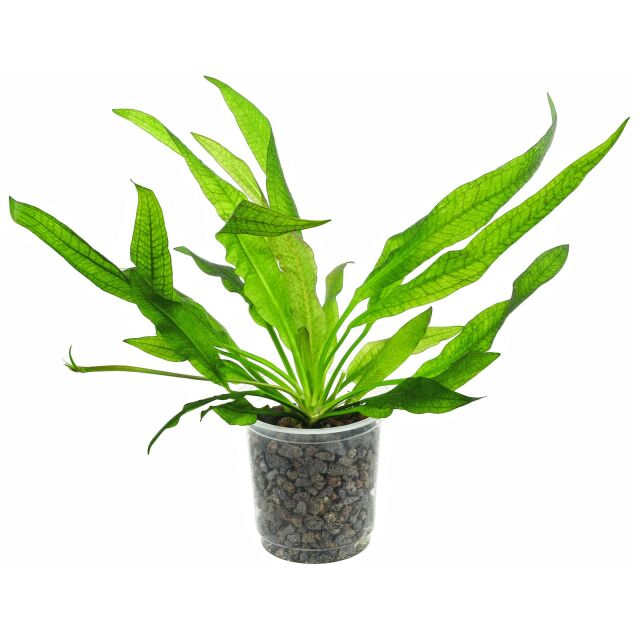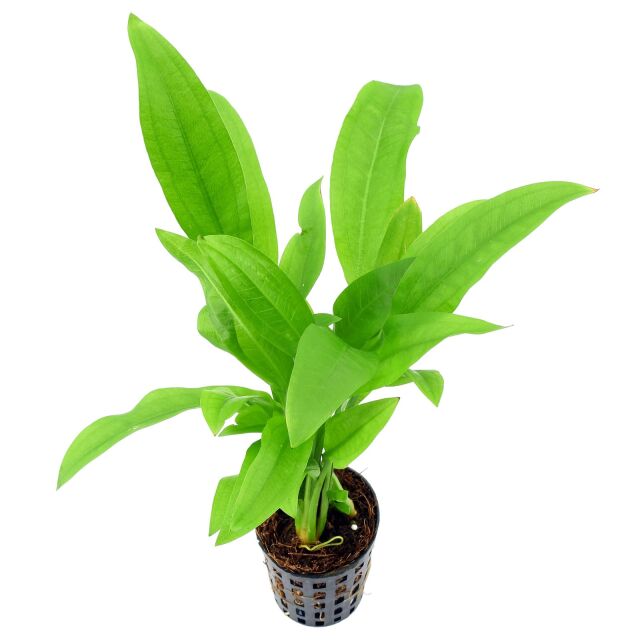Black Amazon Sword




Echinodorus grisebachii 'Parviflorus'
Black Amazon Sword
- Medium-sized Echinodorus wild type
- Solitary plant also for smaller tanks
- Develops many durable leaves
- Undemanding
Sign in or Register
Item question
We’re here for you!
Please enter your question and e-mail and we’ll contact you as soon as possible. It usually takes us up to 24 hours during business days to respond.
Thank you for your question!
Thank you, we’ll get in touch!
Close window
You already sent us a question.
Please wait a few minutes
Description
The Black Amazon Swordplant is named after the dark red-brown nervature pattern on its young, newly appearing leaves. This long known Echinodorus wild type was originally imported from the Amazonian part of Peru and is also known as "Echinodorus peruensis" and E. parviflorus.
Echinodorus grisebachii 'Parviflorus' develops a dense, broad rosette of countless sword-shaped, lanceolate leaves. About 3-4 new leaves appear each month.
Compared to E. grisebachii 'Bleherae' and 'Amazonicus', 'Parviflorus' remains considerably lower and is much more recommended for medium-sized tanks than the two bigger grisebachii forms. It is also less light-demanding.
The Black Amazon Swordplant is commonly known as Echinodorus parviflorus and also under the trade name "Echinodorus peruensis". It truly is a variety of E. grisebachii, a very widely distributed species in the American tropics, among which E. grisebachii 'Amazonicus' and E. grisebachii 'Bleherae' are found. Originally, this form of E. grisebachii was probably imported from the Bolivian and Peruvian Amazon.
Decades ago, some Echinodorus plants were cultivated under the name E. parviflorus that were said to only form flower stalks under short-day conditions. Those plants traded as E. parviflorus today, however, differ from them. The popular name "Black Amazon Swordplant" refers to the dark coloration of the young leaves.
E. grisebachii 'Parviflorus' is a relatively easy-to-care-for sword plant that does not need very intensive light. (read more)
| Synonyms | Echinodorus parviflorus Rataj |
| Trader names | Echinodorus peruensis |
| Complete botanical name | Echinódorus grisebáchii Small |
| Family | Alismataceae |
| Genus | Echinodorus |
| Difficulty | easy |
| Usage | Background, Midground |
| Growth | medium |
| Temperature tolerance | 18 - 30°C |
| General hardness | 0 - 30°dGH |
| Propagation | Proliferating inflorescences, Rhizomteilung |
| Can grow emersed? | yes |
| Source | Flowgrow |
| Synonyms |
| Echinodorus parviflorus Rataj |
| Trader names |
| Echinodorus peruensis |
| Complete botanical name |
| Echinódorus grisebáchii Small |
| Family |
| Alismataceae |
| Genus |
| Echinodorus |
| Difficulty |
| easy |
| Usage |
| Background, Midground |
| Growth |
| medium |
| Temperature tolerance |
| 18 - 30°C |
| General hardness |
| 0 - 30°dGH |
| Propagation |
| Proliferating inflorescences, Rhizomteilung |
| Can grow emersed? |
| yes |
| Source |
| Flowgrow |
General information
| Item no. |
|
| EAN | |
| Weight | 0,10 kg |
| Shipping weight | 0,10 kg |
Customers ask customers
You have questions about this product? Ask other customer or our support team about this product!
Customer reviews
7 Reviews
| 5 Stars(5) |
|
| 4 Stars(1) |
|
| 3 Stars(1) |
|
| 2 Stars(0) |
|
| 1 Star(0) |
|